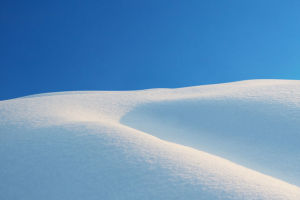Mount Moran, which rises 6,000 feet above Jackson Lake in Grand Teton National Park, is named after Thomas Moran, an American landscape artist. The mountain is a perfect example of the geologic forces that formed the Teton Range.
The mountain core comprises ancient igneous and metamorphic rocks, while sedimentary rocks form the summit, and Little Ice Age glaciers line the slopes. The most noticeable feature on the mountain is a vertical vein of black diabase known as the Black Dike, which slices across the east face of the mountain.
The Black Dike appears to be man-made, but it was formed when molten magma squeezed into cracks in the existing bedrock almost a billion years ago. Erosion later stripped away the surrounding rock, leaving the dike protruding.
Thomas Moran, who accompanied the 1872 Hayden expedition into Yellowstone, produced many sketches and watercolors introducing the Greater Yellowstone area to Easterners. He visited the west side of the Teton Range but never saw the mountain named after him.
For those who want to try climbing the mountain, there are several routes to the summit, but the easiest route is 5.4 Grade III. However, due to the remoteness of the mountain, it should not be taken lightly. The most famous route is the Direct South Buttress, which is included in the Fifty Classic Climbs of North America by Steve Roper and Allen Steck.
The CMC Route, with a difficulty level of 5.5, Grade III, is the most popular route to the summit. It offers a high campsite, a 1500-foot scramble, and a 1000-foot ascent of steep slabs along a vertical black dike. There is also a technical pitch that must be led on the descent to gain the top of Drizzlepuss on the way back to the CMC camp.
This pitch is 5.7 or 5.5, depending on the variation, and is the most exposed section of the entire route. The CMC route is normally climbed in three days, with the first day being the approach to the high camp (4-6 hours).
The summit day is usually between 10 and 14 hours round trip, and the hike out is on the third day. Due to the long duration and relative remoteness of this mountain, the CMC route on Mount Moran is considered the most difficult standard route in the Tetons. The CMC name comes from the Chicago Mountaineering Club, whose members made the first ascent of the route on June 25, 1941.
The first ski descent of the CMC route on Mt. Moran was by Doug Coombs, Bill Dyer, and Kent McBride on May 16, 2002.
The Direct South Buttress, with a difficulty level of 5.7 A3 Grade IV or 5.12 Grade V, is considered a Teton classic and a test piece for Teton mountaineers. It has 14 pitches, and the first ascent was made by Richard Emerson, Don Decker, and Leigh Ortenburger on August 30, 1933.
The first free ascent was made by Stan Mish and Hal Gribble on July 3, 1979. To get to the base of the Direct South Buttress, use a canoe to paddle across String Lake, then portage to Leigh Lake, where you will paddle to the inlet at the entrance of Leigh Canyon.
There will be a nondescript path that can be followed on the north side of the creek for the next mile and a half to the talus slope below Laughing Lion Falls.
Additionally, there are several other routes on Mount Moran, ranging in difficulty and requiring different levels of technical skill. These include the Direct Exum Ridge, the East Ridge, and the Black Dike Route, among others.
Each route offers a unique challenge and a chance to experience the beauty of the mountain and the surrounding area.
However, climbing Mount Moran is not without risk. As mentioned earlier, the mountain's remoteness and technical difficulty make it a serious undertaking.
Climbers must be experienced and prepared for long, strenuous days in a high alpine environment. It is important to have the proper gear, including ropes, harnesses, helmets, and crampons, and to be knowledgeable about the risks and hazards associated with climbing at high altitudes.
Despite the challenges, climbing Mount Moran can be a rewarding and unforgettable experience. The mountain offers stunning views of the Teton Range and the surrounding landscape, and the sense of accomplishment that comes with reaching the summit is unparalleled. For those who are up for the challenge, Mount Moran is a must-see destination in Grand Teton National Park.
Mount Moran is a remarkable mountain located in Grand Teton National Park in Wyoming, USA. Named after the famous landscape painter Thomas Moran, the mountain features several active glaciers and a distinctive basalt intrusion known as the Black Dike.
Mount Moran offers a range of challenging climbing routes, including the famous Direct South Buttress and the CMC Route, as well as several other options for climbers of different skill levels.
Climbing Mount Moran is a serious undertaking, requiring preparation, experience, and technical skill, but the rewards are well worth the effort. For those looking to experience the beauty and challenge of the Teton Range, Mount Moran is an excellent destination.


